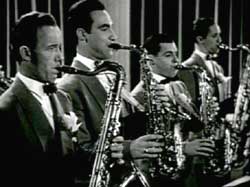 Al Donahue & His Orchestra was one of those "also rans" of innumerable swing bands that filled a contemporary need. He'd been around since the 1920s but he was slow to catch on to swing. Al Donahue & His Orchestra was one of those "also rans" of innumerable swing bands that filled a contemporary need. He'd been around since the 1920s but he was slow to catch on to swing.
Late in the swing era his orchestra became the sort of band you'd encounter in the dance rooms of ocean liners, well-employed, maybe even with recording contracts, but by no means stand-out orchestras.
In 1941 he formed his first true swing orchestra in slavish imitation of Glenn Miller. Practically their first contract was to star in a series of soundies for Phonovue Jukeboxes. Alas, Phonovue's visual jukebox was rapidly plowed under by the better organized Mills Panoram.
The soundies Al's band filmed were not released until a couple years later, when Mills Panoram bought out the Phonovue backlog. His orchestra ended up on Panoram film loops more or less as filler, not because anyone loved the band.
The orchestra provided an unadored performance in the bandstand, doing a jaunty rapid rendition of Anvil Chorus (1943). It's not badly done but a little lackluster. Not being one of the great bands of the era, being completely serviceable & adequate was all that could be relied upon.
Banks of reeds then banks of brass take turns, then there's a sax solo, & yikes who cares. It's so lacking in visual interest there was no reason to record it as a soundie.
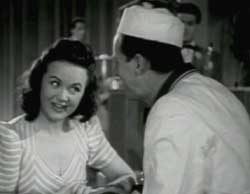 Fortunately not all their soundies were quite so lacking in visual content, nor even so nondescript musically. Fortunately not all their soundies were quite so lacking in visual content, nor even so nondescript musically.
At a coffee stand curiously set up in front of a bandstand, Al Donahue poses as a waiter, bringing coffee to vocalist Ellen Connor who will sing Java Jive (1943).
The attempt to do something cinematic with the song is kind of weak, as all the Donahue Orchestra soundies tend to be; but at least they tried. Ellen sits down at the coffee stand & looks at a menu, though it's a small stand that seems to have only drip coffee & nothing that needed to be on a menu.
The band members stand & shout a litany of beans, but Ellen doesn't want any of those, as if anyone would want coffee made out of lima beans. She sings that she's not here for the bear, another non sequitor for a coffee stand setting.
Ellen looks nice in her gown, though, & the number is one I had a soft spot for even as a kid not yet a coffee addict. Whether performed by the Inkspots, the Puppini Sisters, Manhattan Transfer, or anyone, it's just a nice song, & certainly Ellen Connor doesn't spoil it.
I also like that the song has tangential Northwest connections. The Java Jive was a coffeehouse in Tacoma, Washington, immediately across the Narrows Bridge from where I live today.
For some while it stood empty & I worried it would eventually be torn down if people undervalued it as a landmark. It's main use has been as a fairly seedy working class bar, & the iconic treasured places of the working class are not often spared demolition.
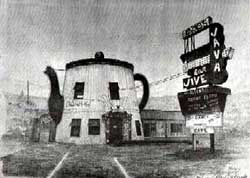 So far, it survives, a building shaped like a coffeepot, how cool is that. I've included a portrait of the Java Jive from the 1970s, very realistically drawn by Gary S. Bennett who gets the romance of the place just right. So far, it survives, a building shaped like a coffeepot, how cool is that. I've included a portrait of the Java Jive from the 1970s, very realistically drawn by Gary S. Bennett who gets the romance of the place just right.
It was built in 1927 & many believe it was called the Java Jive from the beginning so is where the Inkspots' 1940 hit derived its name.
But no, the coffeeshop/bar was not called Java Jive until 1951, more than a decade after Ben Oakland & Milton Drake composed the song. But it had been a famous club even before it took that name, in the 1930s through '50s putting on vaudeville shows, musical events, & acts touring for the USO.
Filmmakers have adored it & the Java Jive has turned up in a number of movies. It was a hang out for Bing Crosby & his family members, some of whom lived in nearby Olympia, & such stars as Clara Bow & Harold Lloyd hung out there in its early days. Urban folklore insists D. B. Cooper had his last cup of coffee there before becoming the world's most notorious airplane hijacker.
It was a "surf rock" hang out when the Ventures made it their hang-out in the late '50s; a punk-rock hang-out & grung rock hang-out in the 80s when Girl Trouble & Nirvana made it one of their resting stations. Alternative country western star Neko Case was once bartender at the Java Jive, & River Phoenix & Keanu Reeves signed their regular table during the filming of the shot-in-the-head comedy I Love You To Death (1990).
But to get back to soundies. Once Java Jive finally gets to the meat of the tune it's very pleasantly done, you know how it goes, "I love coffee I love tea/ I love the java jive & it loves me/ Coffee & tea & the java & me," with all doing the last line of the verse, "A cup a cup a cup a cup a cup..."
Al intruding his voice doesn't improve it I dare say & he should've kept still & just let Ellen sing it. The arrangement isn't much either, another fault of Al's. And Ellen apparently doesn't actually like coffee, as she never even so much as pretends to sip hers.
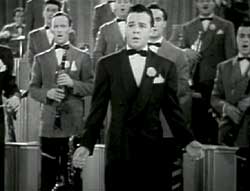 Phil Brito sings lead with most of the Al Donahue Orchestra standing behind him with harmonies on Lonesome Road (1943). Phil Brito sings lead with most of the Al Donahue Orchestra standing behind him with harmonies on Lonesome Road (1943).
Most of the band is not playing instruments, but are swaying & repeating select lyrics, which they shouldn't've done as they're really screwing up the song. The only accompaniment is slap-bass & piano.
It's a great song, so old from the American South that its origins are lost in time, but almost certainly a negro spiritual from slave days. Brito saps it up & whitebreads it, but it's too good a song to be ruined, & he's okay on it, even if making it sound a bit like a song from a B western sung by Roy or Gene.
Unexpectedly there's a drum bashing & the band shouts "Hit the road!" apparently to let Brito know they think he sucks as a singer, in which case why did they bother with this arrangement at all.
The band begins to play an instrumental version at twice its rational speed. I guess it swings all right but it destroys the song, & the two halves of the arrangement just don't fit together.
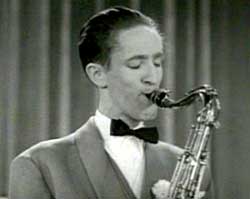 Al Donahue & His Orchestra do a swing version of the "Cross the Volga" number in Volga Boatman (1943), with several instrumental solos one after another including drum solo.
Al Donahue & His Orchestra do a swing version of the "Cross the Volga" number in Volga Boatman (1943), with several instrumental solos one after another including drum solo.
In a weak lot of soundies, this one's probably Al's worst. It's praiseworthy only for the musician portraits we get throughout, & would be a good source of stills for a chapter of a book if anyone thought well enough of the orchestra to write them a chapter.
"The Volga Boatman Song" itself, whatever charm this old Russian folk tune has, would be in the "Yo heave ho!" refrain & Al never figured it out. All he's done is badly imitated Glenn Miller, who turned the folksong into a swing hit in 1941.
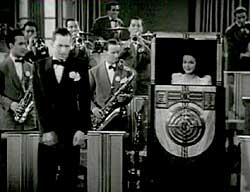 Attempting to make up for the lack of visual value to most of this orchestra's soundies, Jumpin' at the Jukebox rather foolishly places vocalist Ellen Connor inside a hollowed-out Panoram jukebox case.
Attempting to make up for the lack of visual value to most of this orchestra's soundies, Jumpin' at the Jukebox rather foolishly places vocalist Ellen Connor inside a hollowed-out Panoram jukebox case.
She's pretending she's singing on the Panoram. At least we do have something visual going on, but I'm not sure anyone could save the song vocally.
Ellen also sang in Phonovue-produced soundies backed by Herbie Kaye & His Orchestra. She has a good voice but lyrics like "Jump jump jump/ Dig dig dig/ Hep hep hep/ Jump jump jumpin' at the jukebox" couldn't be made hep even if it were sung by Louis Jordan, not even by someone not standing like an idiot inside a box as though ready to be a participant in a Punch & Judy show.
Killing it all the more is the band making it a call-and-response with something to answer between each thrice-sung word. Even Al looks horrified & embarrassed, as though wondering to himself, "Why do I do this?"
copyright © by Paghat the Ratgirl
|
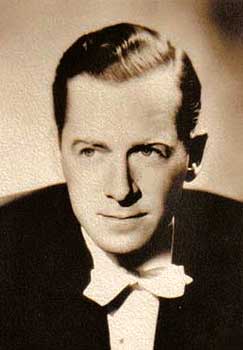


 So far, it survives, a building shaped like a coffeepot, how cool is that. I've included a portrait of the Java Jive from the 1970s, very realistically drawn by Gary S. Bennett who gets the romance of the place just right.
So far, it survives, a building shaped like a coffeepot, how cool is that. I've included a portrait of the Java Jive from the 1970s, very realistically drawn by Gary S. Bennett who gets the romance of the place just right.

